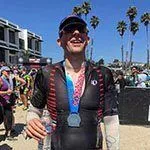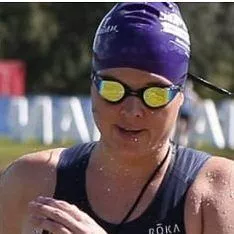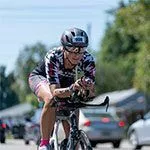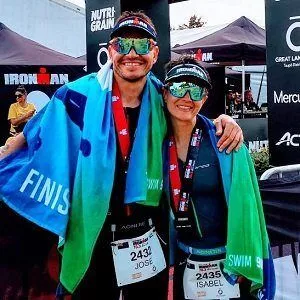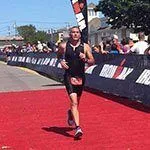Dietary Guidelines for Racing Weight Plans
As an endurance athlete, you will benefit from maintaining consistent eating habits that support health, fitness, and recovery. There are times, however, when it can be helpful to make a few short-term dietary adjustments for the sake of shedding a bit of excess body fat. For example, you might devote a few weeks to getting leaner after a break from training during which you enjoy a few more treats than normal during the winter holidays, as you prepare to get serious about training for your next big race.
The reason that some adjustments may be required at times when addressing your body composition becomes a short-term priority is that the most effective ways to train and eat for endurance performance are not the same as the most effective ways to train and eat for fat loss. Because you are an endurance athlete, performance should be your clear priority at most times and you should train and eat in optimal ways to support this objective. It’s okay to make fat loss a higher priority than performance during brief periods when you’re not actively pursuing peak race fitness, but these periods should be segregated from the normal training process and supported by modified training and eating practices that are optimal with respect to this short-term goal.
Following are five core dietary guidelines for endurance athletes engaging in short-term fat-loss focus phases. You are encouraged to apply them while following your chosen six-week 80/20 Racing Weight Training Plan. When you complete the plan and shift back to performance-focused training, be sure to also shift back to your normal, performance-focused eating habits. For guidance on how to eat for maximum endurance performance, check out Matt Fitzgerald’s book The Endurance Diet.
Don’t set a goal.
The first mistake that many athletes make in the effort to achieve their optimal racing weight is setting a goal to attain a specific weight or body fat percentage—usually a round number. The problem with such goals is that they are utterly arbitrary; there is no way for any athlete to accurately predict the weight or body fat percentage at which they will perform best. Chasing a number that’s not right for you is likely to negatively impact not only your athletic performance but also your health.
It’s important to understand that optimal racing weight is functionally defined. By definition, your optimal weight for competition is the weight at which you perform best and most consistently. Hence, the only way to determine this number with certainty is to actually achieve peak fitness and performance. The relationship between body weight/composition and performance is governed by the principle of “form follows function.” You don’t arrive at peak performance by attaining a certain weight or body fat percentage; rather, you optimize your body weight and composition in the process of attaining peak performance.
Don’t focus too much on numbers.
Because it’s impossible to predict your optimal racing weight, and because the phenomenon is functionally defined, the best way to work toward it is to focus on the process, trusting that by doing so you will eventually get where you need to go. Too often, athletes do the opposite, viewing any weight loss as good weight loss no matter how it is achieved.
It’s okay to weigh yourself or measure your body composition periodically—just don’t allow these measurements to start dictating your behaviors. Follow your training plan and adhere to the dietary guidelines presented here regardless of what the scale tells you.
Monitor your diet quality.
As an athlete trying to shed excess body fat, you need to maintain a careful balance in your diet. On the one hand, you need to somehow reduce your calorie intake, because fat loss is impossible otherwise (assuming your training is consistent). On the other hand, you need to give your body plenty of fuel to train hard and effectively. Reducing your calorie intake too much will compromise your training and defeat the purpose of losing weight.
The best way to reduce your calorie intake without compromising your training is to focus more on the quality of what you eat than on the quantity. Calorie for calorie, high-quality foods offer greater satiety and more total nutrition than low-quality foods. So, by increasing the overall quality of your diet, you will reduce your calorie intake without failing to meet your body’s needs and without the need to count calories or consciously eat less.
High-quality foods are vegetables, fruits, nuts and seeds, whole grains, lean meats and fish, and dairy. Eat these food types more often than you eat any low-quality foods, and try to eat the food types near the beginning of this list more often than those near the end. Low-quality foods include refined grains, fatty meats, sweets, fried foods, and other foods containing added oils. Eat these foods sparingly.
Most people look at their own diet through rose-colored glasses and think it is higher in quality than it really is. Endurance athletes are no exception. Coach Matt’s Diet Quality Score (DQS) app is a handy tool that enables athletes to assess their diet quality objectively and improve it systematically. You can find complete information on what’s included in each food category, how to judge portion sizes, and how scoring works on the app (which is available in iPhone and Droid versions), in The Endurance Diet, and at racingweight.com. We encourage you to track your DQS daily throughout your six-week racing weight program.
Increase your protein intake.
In addition to elevating your diet quality, increasing your protein intake during a short-term fat-loss focus phase will help you reduce your calorie intake automatically, meaning you can continue to eat enough to satisfy your appetite and yet eat less in the process. This was shown in a 2005 study by researchers at the University of Washington, who found that subjects voluntarily ate 14 percent less and lost weight after switching to a 30 percent protein diet.
A second benefit of short-term elevated protein intake is that it increases the percentage of total weight loss that is accounted for by fat versus muscle. In a 2010 study conducted at the University of Birmingham, two groups of athletes cut calories equally to promote weight loss. But one group got 15 percent of their daily calories from protein (which is about normal) while the other bumped their protein intake up to 35 percent. The 15 percent group lost more total weight, but more than half of that weight was lean body mass. Members of the 35 percent protein group lost just as much fat without losing any muscle.
Given these benefits, you might wonder why you shouldn’t eat extra protein year-round. The reason is that high levels of protein intake have been shown to inhibit aerobic adaptations to training. In other words, if you eat too much protein, the same amount of training will make will less fit. This is okay during a short-term weight-loss focus phase, when fitness is not your top priority, but you wouldn’t want to continue the practice within a race-focused training cycle.
Increasing your protein intake is as easy as replacing some of the low-protein foods in your diet, such as grains, with high-quality protein-rich foods including legumes, Greek yogurt, tofu, fish, and unprocessed meat. It’s okay to make limited use of protein supplements, as well. Thirty percent of total calories is a good number to aim for, but might be difficult to reach if your current protein intake level falls well below this mark.
Maintain a moderate calorie deficit.
The optimal calorie deficit for endurance athletes seeking to improve body composition is a moderate one of 300 to 500 per day. If you try to cut more, not only will your training suffer but you will risk losing muscle in place of fat. In a study performed at Rockefeller University, one group of subjects cut their energy intake by 700 calories a day, while a second group cut their energy intake by 300 calories a day. The first group lost more total weight, but it was only 48 percent fat—the rest was lean body mass. Meanwhile, the weight lost by the second group was 91 percent fat.
You might be able to achieve a daily energy deficit of 300 to 500 calories simply by increasing your diet quality and increasing your protein intake. But you might not, in which case you will need to slightly reduce your meal portions during this six-week period. In either case, you will need to calculate your daily calorie expenditure and intake to achieve and maintain this deficit. While continuous tracking of calorie consumption and expenditure is not recommended, it is useful during short-term fat-loss focus phases.
Calculating calorie intake is fairly straightforward. It’s mostly a matter of reading labels, looking things up on NutritionData.com, and measuring portions. Calculating calorie expenditure, on the other hand, is an inexact science. Various online calculators can be used to estimate resting metabolic rate (the number of calories you burn daily at rest) and how many additional calories you burn through activity. Many activity tracking devices also provide estimates of caloric expenditure. Again, though, it is difficult to get an accurate total through these means.
An easier alternative that works for many people is to calculate their current daily calorie intake and cut it by 300-500. This will do the job quite effectively if your weight has been stable recently on your current diet. In any case, the math doesn’t have to work out perfectly. Research has shown that merely trying to maintain a moderate calorie deficit suffices to stimulate fat loss, regardless of how the numbers actually work out.
A Final Word
As you probably know, efforts by athletes to shed excess body fat often don’t end well. Instead of yielding better performance and greater satisfaction with the overall athletic experience, they result in stress, anxiety, body dysmorphia, unhealthy eating behaviors, and even eating disorders. Don’t let this happen to you. Stay focused on what really matters: namely, being healthy and happy, as you will be if you take the guidelines we’ve given you seriously, and seek help from a dietitian or therapist if you see signs you’re heading down the wrong path.









